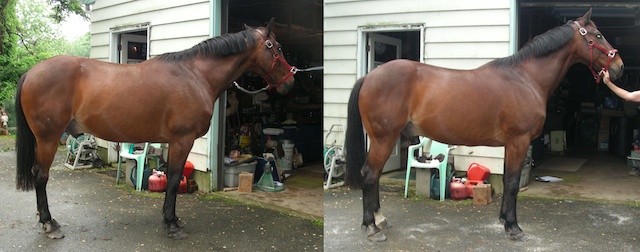With all the different trim styles out there it can be difficult to make value decisions for your horse’s feet. Every horse is different, and depending on the environment, the horse’s job and where you get your hoof care knowledge, there are a lot of nuances to navigate.
One of the most influential paradigms for my hoof care work is Postural Rehabilitation. This is a therapeutic modality that is based on gravity’s influence on the nervous system and how to help the animal overcome postural compensations that are detrimental to the system. Taught by Judith Shoemaker, DVM of Nottingham PA, Karen Gellman, DVM, PhD of Ithaca NY, and Liz Reece, Alexander Technique Teacher, of Chester NY, Postural Rehabilitation has given me a higher order of priorities to the health of the horse that has changed the way I trim and shoe my horses.
For the most part, domesticated horses stand 20+ hours per day, so how they stand is very influential to their bodies. Neutral posture, meaning posture that is least detrimental and the most energy efficient, is cannon bones perpendicular to the ground, the horse standing a leg at each corner.

Horses receive information on how to stand from proprioceptive nerves in the feet, teeth and body. That’s why how we trim the feet so influences the horse’s posture.
The most common compensatory posture the horse assumes is called “Goat-on-a-Rock”:

In the words of Dr. Karen Gellman:
“Goat on a rock posture is a term coined by Dr. Judith Shoemaker for a horse who is “camped in”: front legs pointing back, hind legs pointing front, as if they were standing on a small rock or circus ball. There can be multiple causes of this abnormal compensatory posture, but one of the primary ones is hoof imbalance. When there is too much weight-bearing surface in front of the center of the foot (center of rotation of DIP joint), break-over is delayed and excessive tension is created in the deep digital flexor (DDF) during stance and stance phase of locomotion. The postural centers of the brain interpret this DDF tension as a pattern encountered while on an uphill slope, and respond by leaning up the “imaginary” hill. However, since there is no hill, leaning forward would result in falling on its nose! The body responds by counterbalancing with the hind end, essentially “sitting” on its butt while leaning forward!
In order to maintain this crazy posture, the horse has to recruit muscles normally used for locomotion, because they are the ones in the right place to do that job. However, these muscles were never designed to be “on” all the time, like the postural maintenance muscles, so they fatigue and start generating painful muscle spasms. That’s why most horses who stand “goat on a rock” have sore backs and haunches. For many horses, if they do not have concurrent problems with their teeth or neck, correctly balancing their feet will instantaneously fix their posture, and let them stand neutrally – square like a table, with cannon bones perpendicular to the ground. That way, they get to use minimal muscular effort to support a body that needs to stand for 20+ hours a day”.
Here are a few examples of horses we work on that have demonstrated a change in posture from “Goat-on-a-Rock’ to neutral, cannon bones perpendicular to the ground, by just changing the way the foot was trimmed to a 50/50 base of support from toe to heel around the DIP joint:










